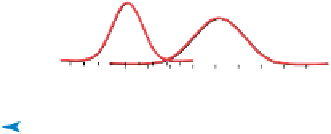Biomedical Engineering Reference
In-Depth Information
Normal operating range =
Proven acceptable range
A
B
Higher risk
Set points
Figure 8.3
When PAR is unknown and considered equal to NOR. (
See insert for color
representation of the figure
.)
(differ-
ence between NOR and PAR limits) (Figure 8.4). It is also important to know
the variability of the parameter within the NOR near the limits (e.g., normal
distributions). This will impact the likelihood or probability of maintaining con-
trol within the NOR. When the risk of exceeding the PAR is negligible or none,
knowledge of the edge of failure (EOF) is insignificant. The EOF could be near or
far from PAR, but would be inconsequential as it would never be reached. Also,
it is possible to tighten the NOR based on historical results and then ascertain
the level of risk.
(II)
When PAR is known
: Compare NOR to PAR and size of the
• NOR is a significantly smaller range than PAR (as depicted in Figure 8.4,
scenario A). The value of
is relatively large and/or the variation of the
Normal operating range
A
B
Set point
Δ
Δ
1
Proven acceptable range
Figure 8.4
Determining level of risk-based on the spread between PAR and NOR,
variability of the operating parameter, and the location of the set-point. (
See insert for
color representation of the figure
.)






























Search WWH ::

Custom Search